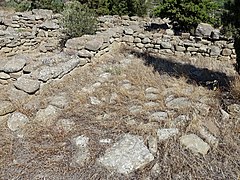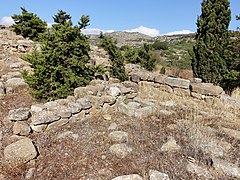Kephala (Chondros)
Kephala ( Greek Κεφάλα Kefala ), also Mikro Kephali ( Μικρό Κεφάλι Mikro Kefali ), refers to an archaeological excavation site in the municipality of Viannos in the central south of the Greek island of Crete . It is located near the locality of Chondros ( Χόνδρος ) with the district of Pervola ( Περβόλα ). The building remains of Kephala are attributed to the Late Minoan period of phase SM III A2 of the post-palace period.
Location and description
The excavation site is located on a range of hills at an altitude of about 450 to 460 meters. The place Chondros is about 500 meters southeast, the district Pervola 350 meters in the northeast. Kephala can be reached on a dirt road that branches off the road to Chondros in Pervola southwest. The south coast of Crete at the bay of Keratokambos (Όρμος Κερατοκάμπου) is about four kilometers away. With Kephali Lazana (Κεφάλι Λαζανά) 100 meters west of Kephala, another archaeological site is known, which is dated to the Middle to Late Minoan period. Remains of large walls and smaller finds have also been discovered on the Anatoliko Kephali hill (Ανατολικό Κεφάλι) to the east.
After a first test excavation in 1956, Kephala was systematically excavated by the Greek archaeologist Nikolaos Platon from 1957 to 1960. Despite the poor state of preservation of the building remains, which were exposed to severe erosion , the importance of the excavation results from the almost complete dating to the otherwise little-known post-palatial phase SM III A2. With a total area of 785 m² (50 × 15–17.5 m), the settlement probably did not exist for more than a century. The groups of buildings, divided by a double wall into an eastern and a western area, built on the leveled hilltop, suggest a community of several large families. Traces of another group of buildings extend westwards to the neighboring hill Kephali Lazana.
In the eastern area of the excavation site there were at least seven houses with 20 rooms. Some of the paved rooms have an earlier, lower pavement. In the rooms there are stone benches and brick storage rooms. Only one room has a base for a roof support. The lack of stairs indicates a single-storey construction. The western area of Kephala has similar pavements, benches and storage areas. There are indications of minor repairs and modifications. A staircase, some of which has been preserved, led to a second floor. The room Δ1 in the central northern area ( 35 ° 2 '5,3 ″ N , 25 ° 22 ′ 34 ″ E ) had a podium and on the upper floor a shrine to which a tubular stand, fragments of a sacrificial table with lions in relief and the Figurine belonged to a woman giving birth. The clay loom weights that have been found many times show that wool was woven in the settlement, presumably from their own sheep.
The buildings of Kephala were destroyed by fire. The largest of the built-up blocks made of flysch sandstone (over 1.0 × 0.5 × 0.3 m) shows flaking as a result of high temperatures. The cause of the fire that led to the destruction and abandonment of the settlement was suspected to be an earthquake or an attack. There is no evidence of a shift in the foundations, often caused by earthquakes. If one follows Eberhard Zangger's criteria for natural disasters in the Aegean Bronze Age , an earthquake can in all probability be ruled out as the cause of the destruction of Kephala.
- Kephala archaeological site
literature
- Nikolaos Platon: Ανασκαφή Χόνδρου Βιάννου . In: Πρακτικά της Αρχαιολογικής Εταιρείας (ΠΑΕ) . No. 112 , 1957, ISSN 2241-4967 , ΥΜ III ΟΙΚΙΣΜΟΣ ΚΕΦΑΛΑΣ ΧΟΝΔΡΟΥ. (Σχέδ. Είκ. 1), p. 136–145 (Greek, digitized version [PDF; 1.4 MB ; accessed on November 21, 2018]).
- Nikolaos Plato: Ανασκαφή μετανακτορικού μινωικού συνοικισμού εις Κεφάλι Χόνδρου . In: Πρακτικά της Αρχαιολογικής Εταιρείας (ΠΑΕ) . No. 114 , 1959, ISSN 2241-4967 , pp. 197–205 (Greek, digital version [PDF; 1.1 MB ; accessed on November 21, 2018]).
- Athanasia Kanta: The Late Minoan Period in Crete. A Survey of Sites, Pottery and their Distribution (= Studies in Mediterranean Archeology . Volume 58 ). Paul Åström, Göteborg 1980, ISBN 978-91-85058-95-2 , p. 114-117 (English).
Individual evidence
- ↑ Antonis Stivaktakis: Χόνδρος Βιάννου και η ιστορία του . In: Ιστορικής Λαογραφικής Αρχαιολογικής Ένωσης Βιάννου (ed.): Βιαννίτικες Ρίζες . No. 3 , 2010, ISSN 1791-3152 , Ιστορία του Χόνδρου, p. 17 (Greek, digitized version [PDF; 7.5 MB ; accessed on November 21, 2018]).
- ↑ a b c Nikolaos Plato : Chondros . In: J. Wilson Myers, Eleanor Emlen Myers, Gerald Cadogan (Eds.): The Aerial Atlas of Ancient Crete . University of California Press, Berkeley, Los Angeles 1992, ISBN 978-0-520-07382-1 , pp. 82–85 (English, excerpt [accessed on November 21, 2018]).
- ↑ Eberhard Zangger : Natural disasters in the Aegean Bronze Age - research history, significance and assessment criteria . In: Eckart Olshausen , Holger Sonnabend (ed.): Stuttgart Colloquium on the Historical Geography of Antiquity 6, 1996 . "Natural disasters in the ancient world" (= Geographica Historica . Volume 10 ). Franz Steiner, Stuttgart 1998, ISBN 978-3-515-07252-6 , earthquake, p. 230–232 ( online [accessed November 21, 2018]).
Web links
- Chondros: Kefala. In: Digital Crete: Archaeological Atlas of Crete. Foundation for Research and Technology-Hellas (FORTH), Institute for Mediterranean Studies(English).
Coordinates: 35 ° 2 '5 " N , 25 ° 22' 34" O






